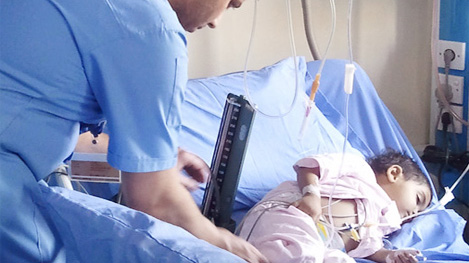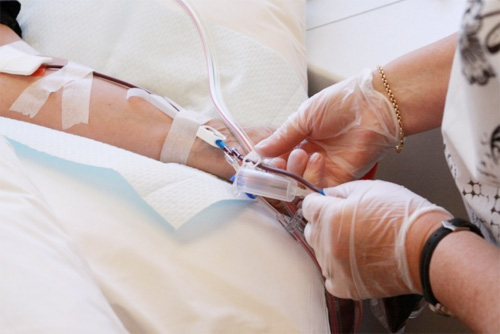|
What is Thalassemia?
Thalassemia is an inherited blood disorder in which the body makes an abnormal form of hemoglobin.
If both of your parents are carriers of thalassemia, you have a greater chance of inheriting a more serious form of the disease.
The two main forms of thalassemia are alpha-thalassemia and beta-thalassemia.
 Thalassemia is an inherited blood disorder in which the body makes an abnormal form of hemoglobin. Hemoglobin is the protein molecule in red blood cells that carries oxygen. The disorder results in excessive destruction of red blood cells, which leads to anemia. Anemia is a condition in which your body doesn’t have enough normal, healthy red blood cells. Thalassemia is an inherited blood disorder in which the body makes an abnormal form of hemoglobin. Hemoglobin is the protein molecule in red blood cells that carries oxygen. The disorder results in excessive destruction of red blood cells, which leads to anemia. Anemia is a condition in which your body doesn’t have enough normal, healthy red blood cells.
Thalassemia is inherited, meaning that at least one of your parents must be a carrier of the disease. It’s due to either a genetic mutation or a deletion of certain key gene fragments.
The two main forms of thalassemia are alpha-thalassemia and beta-thalassemia. In alpha-thalassemia, at least one of the alpha globin genes has a mutation or abnormality. In beta-thalassemia, the beta globin genes are affected.
Each of these two forms of thalassemia has several distinct types. The exact form you have will affect the severity of your symptoms and prognosis
What causes thalassemia?
Thalassemia occurs when there’s an abnormality or mutation in one of the genes involved in hemoglobin production. You inherit this genetic defect from your parents.
If only one of your parents is a carrier for thalassemia, you may develop a form of the disease known as thalassemia minor. If this occurs, you probably won’t have symptoms, but you’ll be a carrier of the disease. Some people with thalassemia minor do develop minor symptoms.
If both of your parents are carriers of thalassemia, you have a greater chance of inheriting a more serious form of the disease.
According to the Centers for Disease Control (CDC), thalassemia is most common in people from Asia, the Middle East, Africa, and Mediterranean countries such as Greece and Turkey.

What are the symptoms of thalassemia?
Your symptoms will depend on the type of thalassemia you have.
• Thalassemia Minor
Thalassemia minor usually doesn’t cause any symptoms. If it does, it causes minor anemia.
• Beta-thalassemia
Beta-thalassemia comes in two serious types, which are thalassemia major, or Cooley’s anemia, and thalassemia intermedia.
The symptoms of thalassemia major generally appear before a child’s second birthday. The severe anemia related to this condition can be life-threatening. Other signs and symptoms include:
• fussiness
• paleness
• frequent infections
• a poor appetite
• failure to thrive
• jaundice, which is a yellowing of the skin or the whites of the eyes
• enlarged organs
This form of thalassemia is usually so severe that it requires regular blood transfusions.
Thalassemia intermedia is a less severe form of beta-thalassemia. People with thalassemia intermedia don’t need blood transfusions.
• Alpha-thalassemia
Alpha-thalassemia also has two serious types, which are hemoglobin H disease and hydrops detalis.
Hemoglobin H disease can cause bone issues. The cheeks, forehead, and jaw may all overgrow. Additionally, hemoglobin H disease can cause:
• jaundice, which is a yellowing of the skin or the whites of the eyes
• an extremely enlarged spleen
• malnourishment
• Hydrops fetalis is an extremely severe form of thalassemia. It occurs before birth. Most individuals with this condition are either stillborn or die shortly after being born.

How is thalassemia diagnosed?
If your doctor is trying to diagnose thalassemia, they’ll likely take a blood sample. They’ll send this sample to a lab to be tested for anemia and abnormal hemoglobin. A lab technician will also look at the blood under a microscope to see if the red blood cells are oddly shaped. Abnormally shaped red blood cells are a sign of thalassemia. The lab technician may also perform a test known as hemoglobin electrophoresis. This test separates out the different molecules in the red blood cells, allowing them to identify the abnormal type.
Depending on the type and severity of the thalassemia, a physical examination might also help your doctor make a diagnosis. For example, a severely enlarged spleen might suggest to your doctor that you have hemoglobin H disease.
What are the treatment options for thalassemia?
The treatment for thalassemia depends on the type and severity of disease involved. Your doctor will give you a course of treatment that will work best for your particular case.
Some of the utilized treatments include:
• blood transfusions
• a bone marrow transplant (BMT)
• medications and supplements
• possible surgery to remove the spleen or gallbladder
• Your doctor may instruct you not to take vitamins or supplements containing iron. This is especially true if you require blood transfusions. People who receive blood transfusions receive extra iron that the body can’t easily get rid of. Iron can accumulate in tissues, which can be potentially fatal.
You may also need chelation therapy if you’re receiving a blood transfusion. This generally involves receiving an injection of a chemical that binds with iron and other heavy metals. This helps remove extra iron from your body.
Some of the utilized treatments include:
• blood transfusions
• a bone marrow transplant (BMT)
• medications and supplements
• possible surgery to remove the spleen or gallbladder
Your doctor may instruct you not to take vitamins or supplements containing iron. This is especially true if you require blood transfusions. People who receive blood transfusions receive extra iron that the body can’t easily get rid of. Iron can accumulate in tissues, which can be potentially fatal.
What is the long-term outlook?
If you have thalassemia, your outlook depends on the type of the disease. People who have mild or minor forms of thalassemia can typically lead normal lives.
Different forms of thalassemia can be severe to mild. In severe cases, heart failure is a danger.
Your doctor can give you more information about your outlook and explain how your treatments can help improve your life or increase your expected lifespan.
|